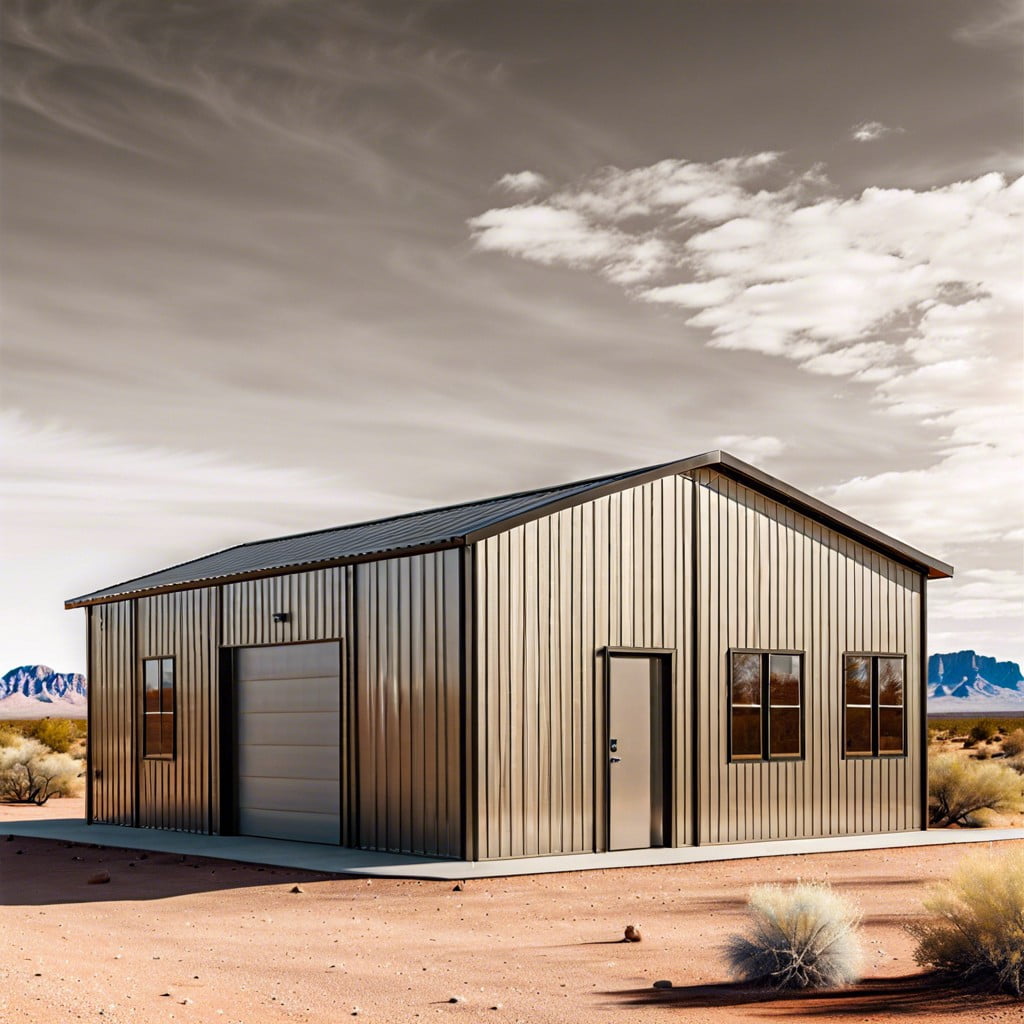This article provides insights into the benefits, considerations, and options available for constructing steel buildings in Arizona.
Key takeaways:
- Steel buildings excel in Arizona’s extreme climate conditions.
- Steel construction offers durability, energy-efficiency, and resistance to weather.
- Securing the necessary permits is crucial before starting construction.
- Steel buildings are cost-efficient and environmentally friendly.
- Arizona steel construction features innovative and customizable designs.
Climate Considerations for Steel Buildings in Arizona

Arizona’s climate poses unique challenges for any construction, due to its extreme heat and occasional intense monsoon storms. Steel, with its superior durability, excels in such environments. It does not warp, crack, or swell like wood, making it ideal for the arid, hot conditions prevalent across the state. Additionally, steel’s resistance to fire is a major asset in areas prone to wildfires.
In areas like Flagstaff where snow and colder temperatures are factors, steel’s structural integrity remains uncompromised. This material’s versatility also means it can be effectively insulated, making it energy-efficient despite the scorching summer temperatures in cities like Phoenix and Tucson.
Moreover, the material’s ability to withstand high winds is critical during Arizona’s monsoon season. Properly anchored steel buildings can sustain wind speeds that would typically damage other materials. This makes steel a prudent choice for ensuring the longevity and safety of structures in this diverse climate.
Advantages of Steel Construction in Harsh Weather
Steel construction offers remarkable endurance against Arizona’s extreme heat and sudden monsoon rains. The high thermal conductivity of steel means buildings stay cooler in the scorching summer months, reducing energy costs for air conditioning. Additionally, steel’s innate strength provides enhanced resistance to wind and rain, making it a reliable choice for areas prone to sudden weather changes.
Moreover, steel does not warp, crack, or split under intense heat, maintaining structural integrity over time. It’s also impervious to termites and other pests prevalent in warmer climates, which can wreak havoc on wood-based structures. This durability translates to lower maintenance costs and fewer repairs over the building’s lifespan, making steel a financially savvy option long-term.
Permitting Process for Constructing Steel Buildings
Before diving into construction, securing the necessary permits is a crucial step. Begin by contacting your local building department for specific requirements. Typically, they demand detailed drawings and blueprints showing the proposed structure’s design and layout. Highlight potential zoning issues, as some areas limit the construction of metal buildings. Thirdly, ensure your plans comply with local building codes, which cover safety standards against environmental stresses like high winds. Often, a structural engineer’s approval is required to move forward. By understanding and anticipating these requirements, you can streamline the permit acquisition process and avoid costly delays.
Cost Analysis of Steel Buildings Versus Traditional Materials
Steel buildings offer several cost-efficient advantages over traditional construction materials like wood and concrete. Firstly, the durability of steel generally leads to lower maintenance costs over time. Steel doesn’t succumb easily to the ravages of pests, mold, or fire, which can result in substantial savings.
Secondly, steel’s prefabrication in a controlled environment aids in reducing construction times significantly. This decrease in labor time translates into direct cost savings for project labor costs. The quicker construction process also allows businesses to commence operations sooner, potentially generating revenue earlier than expected.
Additionally, steel’s high recyclability can further lower the costs. Recycled steel is often cheaper than new steel and still maintains the same durability and strength properties. This makes steel not only a cost-effective choice but also an environmentally friendly one.
Lastly, insurance costs for steel structures are often lower compared to those for wood or concrete. The material’s resistance to fire and termite damage makes it a lower-risk option, which insurance companies usually reward with reduced premiums.
Innovative Designs in Arizona Steel Construction
Architects and engineers in Arizona are pushing the boundaries with steel to create buildings that are both functional and visually striking. The use of curved steel beams, for instance, allows for designs that feature expansive, uninterrupted spaces. This technique is perfect for large commercial venues and warehouses where column-free interiors are highly beneficial.
Another trend is the integration of energy-efficient elements. Steel buildings are often equipped with solar-reflective panels and advanced insulation systems. These enhancements align with the sustainability goals while tackling the harsh sun of the region.
Customization is also a significant aspect of modern steel construction in Arizona. Advanced laser-cutting technology offers precision in crafting unique facades and intricate decorative elements. This allows builders to provide customized solutions that cater to the diverse aesthetic preferences of clients, without compromising structural integrity.
Each of these innovations contributes to making steel a versatile and wise choice for construction in the desert climate of Arizona.
Related Reading:
- 100×200 Steel Building: Costs, Benefits, and Installation Tips
- Pole Barn vs Steel Building: Understanding Key Differences and Benefits
- Central Texas Steel Buildings: Benefits and Buying Tips
- Metal Workshop Buildings: Benefits, Types, and Installation Tips
- Steel Building vs Wood Frame Cost: Which is More Economical?